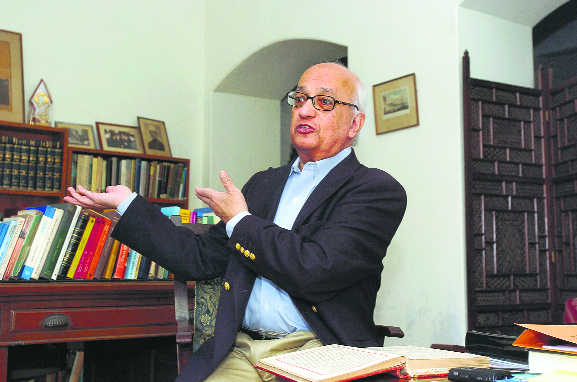The case of Raja of Mahmudabad: How law turns him an ‘enemy’
Shahira Naim in Lucknow
What hurts Raja of Mahmudabad, Amir Mohammad Khan, most is his sudden description as an 'enemy.' The amended Enemy Property Act disinherits Raja-saheb from his ancestral property and also brings him within the definition of 'enemy.'
On Oct 22, 2005 the Supreme Court passed a judgment through which properties spread across Uttar Pradesh and Uttrakhand were restored to the erstwhile Raja of Mahmudabad after a 32-year legal battle.
The judgment had cleared the stigma of enemy property from the family's name. Last month it has returned to haunt the family. The Raja, popularly known as Suleiman, is an occasional professor of astrophysics at Imperial College, London, and Institute of Astronomy at Cambridge University and from where he had earlier done his mathematics tripos.
“The late Raja of Mahmudabad, Raja Amir Ahmad Khan, was a worthy member in the long line of maharajas of Mahmudabad. The family took part in the 1857 uprising for which it was punished with confiscation of a large part of its estate.” This is what Indira Gandhi had to say about his father in 1984 in a book titled The Life and Times of Raja Saheb of Mahmudabad by Syed Ishtiaq Hussian.
His great great-grandfather Raja Nawab Ali Khan-Muqeem ud Daula's contribution to the first war of independence is recorded even in Surendranath Sen's official history of the uprising brought out by the information & broadcasting ministry during the centenary year in 1957. His grandfather was the first vice-chancellor of Aligarh Muslim University, an institution he helped set up.
"My family has contributed so much to the country — Lucknow University, King George Medical College, Amir Daula Library and so many premier educational institutions. My great grandfather set up a school in Mahmudabad way back in 1885. And here I am struggling to fight a mindset which sees us as traitors," says the Raja.
The Raja refuses to talk about the case filed by him remarking that the matter was sub judice. His counsel Niraj Gupta points out that the case challenging the ordinance has been pending, and that there has been no hearing for a long time. He points out that the Enemy Property (Amendment and Validation) Act, 2016, is bad in law mainly because it is retrospective in application, going back to 1968. It annuls the legal sales undertaken by 'enemies' since 1968.
Most significantly, it widens the definition of 'enemy subject' to include Indian citizens which amounts to altering the original intention of the 1968 Act.
Calling it a violation of Article 14, Gupta argues that the classification places the descendants of enemy subjects, who otherwise have no ties to the former enemy state, on the same level as the original enemy subjects. "This is arbitrary and unreasonable."
The law works to disinherit and deprive generations of Indian citizens who have resided in India and bear allegiance to the Indian nation from their rightful property simply because their ascendants had migrated to Pakistan or were of Chinese origin. It was the Supreme Court verdict in favour of the Raja in 2005 that unfolded the sequence of events leading to the passing of the Enemy Property (Amendment and Validation) Bill, 2016 in the Lok Sabha last month.
The Raja of Mahmudabad has the highest number of properties vested in the custodian amounting to 936 strewn across Uttar Pradesh and Uttarakhand. It includes the majestic Butler Palace in the heart of the city of Lucknow which is in a state of ruins. It once housed the library of the Indian Council of Philosophical Research. In Lucknow’s downtown area of Hazratganj is the Mahmudabad Mansion and Lawrie Building which are prime real estate holdings.
While the fashionable Hotel Metropol in Nainital is well known, what is known little is that estate in Sitapur which includes a sugar mill, a polytechnic institute, a degree college, sports stadium, and 956 acres being cultivated by thousands of farmers leased out to them by the custodian of enemy properties.
But the loss of the Qila in Mahmudabad, the seat of Shia mourning during Moharrum, has shaken the Raja the most. The Qila had maintained the tradition of holding the Moharrum rituals year after year led by none else but Raja-saheb himself.









